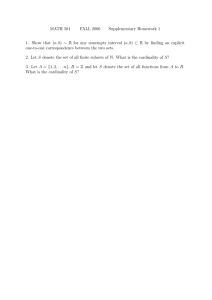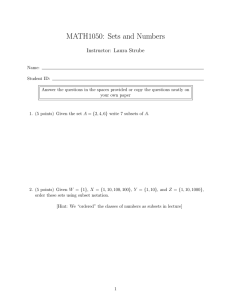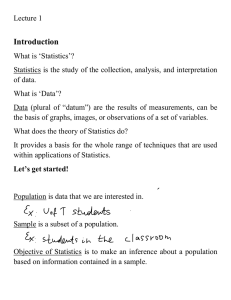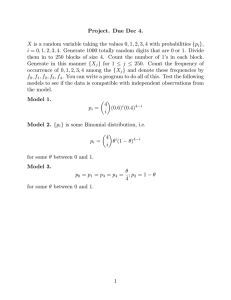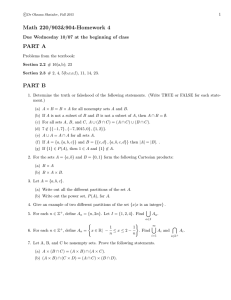Consistency of natural relations on sets Hirotaka KOIZUMI , Akira MARUOKA
advertisement
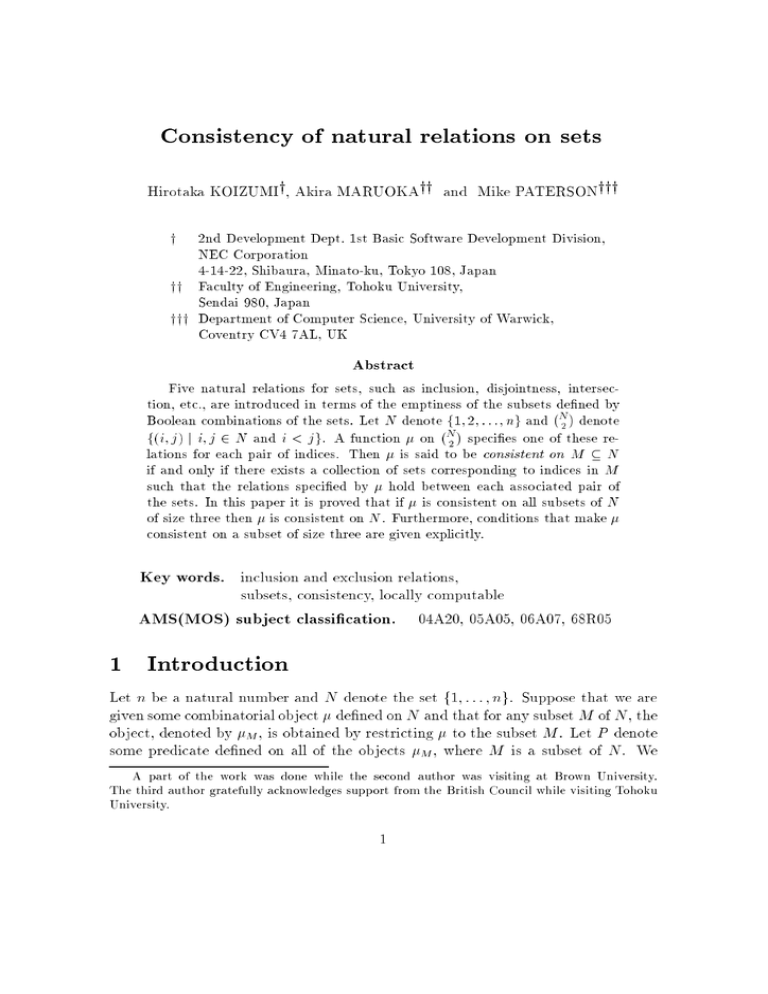
Consistency of natural relations on sets
Hirotaka KOIZUMIy, Akira MARUOKAyy and Mike PATERSONyyy
y
2nd Development Dept. 1st Basic Software Development Division,
NEC Corporation
4-14-22, Shibaura, Minato-ku, Tokyo 108, Japan
yy Faculty of Engineering, Tohoku University,
Sendai 980, Japan
yyy Department of Computer Science, University of Warwick,
Coventry CV4 7AL, UK
Abstract
Five natural relations for sets, such as inclusion, disjointness, intersection, etc., are introduced in terms of the emptiness of the subsets dened
by
Boolean combinations of the sets. Let N denote f1; 2; : : :; ng and N2 denote
f(i; j ) j i; j 2 N and i < j g. A function on N2 species one of these relations for each pair of indices. Then is said to be consistent on M N
if and only if there exists a collection of sets corresponding to indices in M
such that the relations specied by hold between each associated pair of
the sets. In this paper it is proved that if is consistent on all subsets of N
of size three then is consistent on N . Furthermore, conditions that make consistent on a subset of size three are given explicitly.
Key words. inclusion and exclusion relations,
subsets, consistency, locally computable
AMS(MOS) subject classication. 04A20, 05A05, 06A07, 68R05
1 Introduction
Let n be a natural number and N denote the set f1; : : : ; ng. Suppose that we are
given some combinatorial object dened on N and that for any subset M of N , the
object, denoted by M , is obtained by restricting to the subset M . Let P denote
some predicate dened on all of the objects M , where M is a subset of N . We
A part of the work was done while the second author was visiting at Brown University.
The third author gratefully acknowledges support from the British Council while visiting Tohoku
University.
1
consider predicates P that are inheritable, in the sense that if P holds on M then
P holds on M for any M 0 M . Such a predicate P often turns out to be \locally
computable", i.e., if P holds on all objects M with M satisfying some conditions
then P holds on the whole object N . One typical example of such a predicate
is given by Helly's Theorem [H]. For example, in two dimensions, this states that
a family of compact convex planar sets has a nonempty intersection if and only if
every triple of the sets has a nonempty intersection.
In this paper we give another locally computable predicate for which we are only
required to check the predicate on all objects M for \small" M . First we describe
ve natural relations between sets, denoted by , , k, ?, ./, representing strict
inclusion in each direction, disjointness, covering the universe, and the general case,
respectively, Each can be dened in terms of the emptiness or otherwise of Boolean
combinations
of the sets, and the set of these ve relations is denoted by R. Let
N denote f(i; j ) 2 N j i < j g. Each object we deal with is an assignment of a
natural relation to each pair (i; j ) in N , i.e., a function from N to R.
A collection of sets S ; : : : ; Snis compatible with if the relation (i; j ) holds
between Si and Sj for all (i; j ) in N . If is compatible with some such collection
then is said to beconsistent
. For any subset M N , the object M is simply the
M
restriction of to
. If M is consistent then is said to be consistent on M .
Our main result is that if is consistent on every subset of N of size three, then is consistent. Conditions that make consistent are given explicitly in terms of the
natural relations that may hold for any three subsets.
The problem of characterizing a predicate on graphs, or equivalently a family of
graphs satisfying the predicate, is also discussed in [FL] in a dierent context. And it
is pointed out that to nd a nite number of combinatorial structures to characterize
a family is crucial. Some combinatorial aspects of inclusion and exclusion and their
relation to Boolean complexity are also discussed in [LN].
In Section 2, after natural relations on sets have been introduced, some constraints on natural relations of are given which guarantee that is consistent. In
order to prove the statement, a set of vectors is used as a model for . It is also
shown
that there exists a feasible algorithm which, given a partial function from
N to R, decides whether or not can be extended to obtain a consistent total
function. In Section 3, a graph based on the inclusion relations of is introduced as
another intuitive model for , and the same result as in Section 2 is veried using
the model. In Section 4, some open problems are presented.
0
2
2
2
2
1
2
2
2
2
2 Consistency conditions for natural relations
Let the universe U be nonempty. A natural relation for any set or sets is one
that is dened in terms of the emptiness or otherwise of the subsets dened by
Boolean combinations of the sets. For one set, there are four cases, depending on
the emptiness of the set and its complement. If both are empty then S = , a case
we have excluded. The remaining three cases correspond to the set being empty,
equal to the universe and proper, respectively. A subset S of U is called proper if
neither S = nor S = U . We will allow only the proper subsets of U .
For two sets A and B , there are formally 16 possible relations. Under our
assumptions that the universe is nonempty and both sets are proper, there remain
just seven cases. One is A = B , another is A = B = U :B . Both of these cases are
special in that if they hold then one of the sets can be eliminated by substitution from
the remaining relations. The remaining ve natural relations constitute R. Table 1
denes these ve relations in terms of the emptiness, denoted by 0, or nonemptiness,
denoted by 1, of four subsets. In the Table, (a; b) indicates the subset Aa \ B b, where
a and b are in f0; 1g, S = S and S = S .
relations
subsets k ? ./
(1,1)
1 1 0 1 1
0 1 1 1 1
(1,0)
1 0 1 1 1
(0,1)
1 1 1 0 1
(0,0)
1
0
Table 1:
Five natural relations
Let denote f0; 1g. For v in n , let v i denote the i component of v. Given
n subsets S ; : : : ; Sn of U , we can determine whether each subset of the form
( )
th
1
S v \ S v \ Snv n
(1)
1
(2)
( )
2
is empty or not, where v = (v ; : :n:; v n ) is in n . Let VS denote the set of vectors
v in n such that S v \ \ Snv is nonempty. Furthermore let Ti for 1 i n
denote the set of vectors v in VS such that v i = 1. Then it is easy to see that
consistency of S ; : : :; Sn for R is the same as that of T ; : : :; Tn. In other words, for
any natural relation , SiSj holds if and only if TiTj holds. So, without loss of
generality, we can consider a set of vectors V rather than a collection of subsets as
far as the consistency problem is concerned.
(1)
(1)
( )
( )
1
( )
1
1
3
Relation in Table 1 is considered to be a function from to in the obvious
way: for (a; b) in , (a; b) = 1 if Aa\B b is nonempty in the relation, and (a; b) = 0
otherwise. Relation can also be considered to be the set of vectors in for which
the function takes value 1, e.g., = f(1; 1); (0; 1); (0; 0)g. Let v i;j denote (v i ; v j ),
and V i;j denote fv i;j j v 2 V g. This notation can be generalized
in an obvious
N
way to the case of more indices. Let be a function from
to R, and let M N .
i;j
Wesay that is compatible with V on M if and only if V = (i; j ) for all (i; j )
in M , and that is consistent on M if and only if there exists a subset V of n
that is compatible with on M . In particular, when M = N , the phrase \on M "
in the denition may be dropped.
Proposition
1. Let be consistent. Let V 0 denote the set fv 2 n j 9 (i; j ) 2
N ; (i; j )(v i ; v j ) = 0g. Then is compatible with n :V 0.
The proof is immediate from the denitions of consistency and compatibility.
Note that, with and V 0 as in Proposition 1, n:V 0 is the largest set of vectors
that is compatible with in the sense that if is compatible with V , then we have
V n :V 0.
For u in n and A n, let u A = fu v j v 2 Ag, where u v denotes
the vector obtained by taking the bit-wise \exclusive or" of u and v. For u in
n, the transformation 'u on the set of functions from N to R is dened as
'u()(i; j ) = u i;j (i; j ). Note that, in the denition, (i; j ) is thought of as a
subset of .
Clearly we have the next proposition.
Proposition 2. Let u be in n and V n . Then is compatible with V if
and only if 'u () is compatible with u V .
In view of Proposition 2, we have the next proposition which says that the
transformation 'u preserves the consistency of for any u in n .
Proposition 3. Let u be in n . Then is consistent if and only if 'u () is
consistent.
Before proceeding to the main theorem, we show in Figure 1 how the ve natural
relations are transformed by 'u for u = (1; 0) and (0; 1).
It is convenient to extend the denition of any object to f(j; i) j i < j g in the
obvious way, so that (i; j ) = if and only if (j; i) = , and (i; j ) = (j; i) if
(i; j ) 2 fk; ?; ./g.
If is consistent then the transitivity of inclusion implies that the following
constraint holds for any distinct indices i; j and k.
() if (i; j ) = and (j; k) = then (i; k) = .
By applying Proposition 3 for various choices of u, we can transform the constraint
2
2
2
(
(
)
(
)
2
(
)
2
( )
2
( )
2
(
)
2
4
)
( )
( )
(1; 0)
(0; 1)
k
(0; 1)
(0; 1)
?
(1; 0)
./
(1; 0)
Figure 1: Transformations on natural relations
() in various ways. For example, let u i;j;k = (1; 0; 1) and 0 = u (). Now, if
(i; j ) = ? and (j; k) = k then 0(i; j ) = and 0(j; k) = , and so 0(i; k) = ,
which implies that (i; k) = . In Table 2 we show the eight transitivity constraints
which are obtained. If satises these eight constraints it is said to be transitive.
(i; j ) (j; k) (i; k)
u
(0,0,0) k
k
(0,0,1) (0,1,0)
k
?
k
k
(0,1,1)
?
(1,0,0) ?
(1,0,1) ?
k
?
?
(1,1,0) (1,1,1) Table 2: The eight transitivity constraints
(
)
(i;j;k )
The next theorem says that these conditions that are necessary to make consistent on any set of three indices turn out to be sucient conditions to make consistent on the set of all indices.
Theorem 4. If is transitive then is consistent.
Proof. We shall prove the statement of the theorem by induction on n. The
statement holds trivially when n = 2. Assume that the statement holds for n 1,
where n 3.
Let N 0 = f1; 2; : : : ; n 1g. In view of Figure 1, it is easy to see that there exists
some u in n such that 'u()(i; n) 2 f; ; ./g for all i in N 0. By Proposition 3
5
it suces to show that 'u () is consistent. Furthermore, it is easy to see that if
satises the conditions of the theorem then 'u () also satises the conditions.
So, denoting 'u() again by , we may assume that satises the conditions of
the theorem and that (i; n) 2 f; ; ./g for all i in N 0. We will show that is
consistent.
Let
V = fv 2 n j 9 (i; j ) 2 N ; (i; j )(v i;j ) = 0g;
V = fv 2 n j 9 i 2 N 0; (i; n)(v i;n ) = 0g;
V 0 = n :V ;
V = n :V :V :
Let 0 be the function obtained by restricting to N . Then by the induction
hypothesis and Proposition 1, 0 is compatible with V 0.
Fact 1. For any v in V 0 at least one of (v ; : : :; v n ; 0) and (v ; : : :; v n ; 1)
is in V .
Proof. Assume to the contrary that there exists v in V 0 such that both of
(v ; : : :; v n ; 0) and (v ; : : :; v n ; 1) belong to V . Then, since (k; n) 2
f; ; ./g for any k in N 0, there exist i and j in N 0 such that
(i; n) = ;
(j; n) = ;
v i = 1;
v j = 0:
Hence by transitivity we have (i; j ) = , which, together with v i = 1 and v j = 0,
implies that v belongs to V , contradicting the assumption.
2
By Fact 1 we have
V i;j = V 0 i;j
and Propofor any (i; j ) in N . On the other hand, by the induction hypothesis
sition 1 we have V 0 i;j = 0(i;j ) = (i; j ) for any (i; j ) in N . Hence we have
V i;j = (i; j ) for any (i; j ) in N .
So it remains to show that
V i;n = (i; n)
holds for any i in N 0. For v in n and relation , let
A(v) = fi 2 N 0 j v i = 1; (i; n) = g;
B(v) = fi 2 N 0 j v i = 0; (i; n) = g:
0
1
(
)
2
(
2
)
1
1
2
0
2
(1)
(1)
(
1)
(1)
(
(
1)
1)
(1)
(
2
( )
( )
( )
1
(
)
(
)
0
2
(
(
)
0
)
2
0
2
(
)
( )
( )
6
( )
1)
Note that from the assumption we only have to consider the case where belongs
to f; ; ./g.
Fact 2. Let v be in V 0. Let (v) and (v) be vectors in n such that
0
1
(
j 2 A(v) or j = n;
(v) = 0v j ifotherwise
;
j
( )
0
( )
(
j 2 B(v) or j = n;
(v) j = 1v j ifotherwise
:
Then (v) and (v) are in V .
Proof. Let (v) and (v) be denoted by v and v , respectively. It is easy to
see that (i; n)(vbi;n ) = 1 for any b in and any i in N 0, and hence vb 62 V for any
b in . So it suces to show vb 62 V for any bin . To do so, we assume to the
contrary that there exist b in and (i; j ) in N such that (i; j )(vbi;j ) = 0. Since
(i; j )(v i;j ) = 1 for all (i; j ) in N , at least one of vbi 6= v i and vbj 6= v j holds.
Without loss of generality, we may assume that b = 0 and v i 6= v i . So we only
( )
1
0
( )
1
0
(
1
)
0
1
2
1
(
0
2
(
( )
0
)
( )
( )
2
)
( )
0
( )
( )
need to consider the following cases.
Case 1. i 2 A (v); v j = 0 and (i; j ) = ?.
Since (j; i) = ? and (i; n) = , by transitivity (see Table 2) we have (j; n) = ?,
which contradicts the assumption that (k; n) 2 f; ; ./g for any k in N 0.
Case 2. i 2 A (v); v j = 1 and (i; j ) = .
Since (j; i) = and (i; n) = , by transitivity we have (j; n) = , which
contradicts v j = 1.
2
i;n
0
0
Fact 3. Let (i; n)(v ) = 0 for some i 2 N and v 2 V . Then for any
(a; b) 2 other than v i;n , there exists v0 2 V such that v0 i;n = (a; b).
Proof. Let i and v be as in the hypothesis. Without loss of generality we may
assume that (i; n) = , and v i;n = (1; 0) for some i 2 N 0 and v 2 V 0.
Since v 2= V , Fact 1 implies that w = v (0; : : : ; 0; 1) 2 V , and w i;n = (1; 1).
Since (v) 2 V and i 2 A(v), we have (v) i;n = (0; 0). Finally, since (v) 2
V V 0, we have ( (v)) 2 V , and ( (v)) i;n = (0; 1).
2
By the induction hypothesis we have that V 0 i;n = f(0; 0); (0; 1); (1; 0); (1; 1)g for
any i in N 0. Thus, by Fact 3, V i;n = (i; n) holds for any i in N 0, completing the
proof of the theorem.
2
Before closing the section, we note that using Theorem
4 we can construct a
feasible algorithm which, given a partial function from N to R decides whether
or not can be extended to obtain a consistent total function. The algorithm
works as follows. Given a partial function , check if it satises the transitivity
constraints. If not, give the answer that is not consistent. Otherwise, extend ( )
0
( )
0
( )
0
(
2
(
)
)
(
(
)
)
(
0
(
0
1
0
1
0
(
0
)
(
(
)
)
)
2
7
)
using the transitivity constraints repeatedly until none of these constraints can be
applied. In doing this, if there exists a pair to which dierent relations are assigned
then give the answer that is not extensible consistently. Otherwise, conclude
that is extensible consistently. In fact, if we assign ./, to any pairs that remain
unspecied at the end of the algorithm, we obtain a total function. Clearly the
total function obtained in this way is an extension of and is consistent in view of
Theorem 4.
3 An intuitive model for In this section we shall introduce another, intuitive, model for based directly on
the natural relations, so that we can give another proof of Theorem 4.
n
Proposition 5. If is transitive then there
exists u in such that 'u ()(i; j ) 2
N
R = f; ; k; ./g holds for any (i; j ) in .
Proof. Let be transitive. Then it is easy to see that 'u() is also transitive
for any u in n . We shall prove the conclusion of the proposition by induction on
n. When n = 2, Figure 1 shows the result at once. Let N 0 = f1; 2; : : : ; n 1g and
assume as the inductive hypothesis that the result holds for N0. Then there exists
u0 in n such that 'u ()(i; j ) 2 R holds for any (i; j ) in N . Now at most one
of and ? appears in 'u ()(1; n), 'u (2; n); : : : ; 'u (n 1; n). This is because,
if there exist i; j in N 0 such that 'u ()(i; n) = ? and 'u ()(j; n) = , then by
transitivity we have 'u (i; j ) = ?, contradicting the assumption. Thus by taking
u = u0 (0; : : : ; 0; 1) if there exists i in N 0 such that 'u ()(i; n) = ?, and taking
u = u0 otherwise, we see from Figure 1 that 'u()(i; j ) 2 R holds for any (i; j ) in
N , completing the induction step.
2
Let 'u() be as in Proposition 5. We note that in order to obtain a model for it is sucient by Proposition 2 to obtain a model
for 'u (). We denote again 'u()
N
by so that (i; j ) 2 R for any (i; j ) in . We shall dene a collection of subsets
that is compatible with . To do this, consider the directed graph G0 with vertex set
V 0 = fx ; : : : ; xng and edge set E 0 = f(xi; xj ) j (i; j ) = g. Since is transitive,
G0 is an acyclic graph, and we dene Si0 to be the set of xi and its descendants. It
is easy to see that Si0 Sj0 if and only if (xi; xj ) 2 E 0, and if and only if (i; j ) = ,
so that G0 already gives a model for the set containment relations of .
For a complete model for we need to extend G0 with extra vertices. Dene
00
G = (V 00; E 00), where V 00 = V 0 [ fxi;j j (i; j ) = ./ and i < j g and E 00 =
E 0 [ f(xi; xi;j ); (xj ; xi;j ) j xi;j 2 V 00g. As in the case of graph G0, let Si00 be the set
of xi and its descendants in the graph G00. If there exist i and j in N such that
Si00 [ Sj00 = V 00 holds, then let V = V 00 [ fx1g and E = E 00. Otherwise, let V = V 00
0
2
0
0
0
2
0
0
0
0
0
0
0
0
2
0
2
1
8
and E = E 00. The nal graph G is dened to be (V; E ). Now we dene Si to be the
set consisting of xi and its descendants in the graph G. The containment relation
on the new sets is the same as in the graph G0 and agrees with (). Therefore, if
(i; j ) = ./ then neither containment can hold between Si and Sj but xi;j 2 Si \ Sj .
Hence, since Si [ Sj cannot be the whole set V , we have Si ./ Sj . For the proof
of the converse, suppose that Si ./ Sj and so (i; j ) 2 fk; ./g. If there is some xk
in Si \ Sj then k 6= i; j , so Sk Si and Sk Sj . Hence (k; i) = (k; j ) and
the transitivity constraints imply that (i; j ) 6= k. Otherwise there is some xk;l in
Si \ Sj where Sk Si and Sl Sj , and so (I) k = i or (k; i) = , and (II) l = j
or (l; j ) = . If (i; j ) = k then the constraints with (I) and (II) yield (k; l) = k.
This result is contradicted by the existence of xk;l and this completes the proof that
the graph G is a model for .
1
4 Concluding remarks
We investigated the problem of deciding whether or not a function that species
the type of the natural relation for each pair of sets is consistent, and proved that
if is consistent on any three sets then is consistent on the whole collection of
sets. So the problem of deciding the consistency of for n sets can be computed
in time O(n ). Furthermore, it can be seen [J] that the problem can be solved in
time O(n : ). To show this fact, let M be the matrix whose (i; j ) component
is 1 if (i; j ) = , and 0 otherwise. Then the constraint () in Section 2 can be
written as M M M , where the matrix product is done using Boolean sum and
product, and \ " holds between matrices if and only if \ " holds between all the
corresponding components in the matrices. Likewise, we can rewrite the remaining
transitivity constraints in Table 2 in matrix terms. Since the product of two n n
matrices can be computed in time O(n : ) [CW], the consistency problem for n sets
can be computed in time O(n : ).
Finally we leave the following as an open question. Can the result in the present
paper be generalized to \natural relations" with r arguments where r > 2? More
specically, can we prove or disprove that if is consistent on any subset of size less
than or equal to 2r 1 of N then is consistent on N ? A reasonable restriction
of natural relations might be to those relations on r sets in which for every i
in f1; : : :; rg there exists b in such that v i = b implies (v) = 1. Does this
restriction make it easier to resolve the question?
3
2 37
2 37
2 37
( )
9
References
[CW]
[FL]
[J]
[H]
[LN]
D. Coppersmith and S. Winograd, Matrix multiplication via arithmetic
progressions, J. Symb. Comput., 9, 3 (1990), pp. 251{280.
M. Fellows and M. Langston, Nonconstructive tools for proving
polynomial-time decidability, JACM, 35 (1988), pp. 727{739.
S. Jimbo, Private communication.
Mengen konvexer Korper mit gemeinschaftlichen Punkten,
E. Helly, Uber
Jahresber. Deutsch. Math. Verein 32 (1923), pp. 175{176.
N. Linial and N. Nisan, Approximate inclusion-exclusion, Proc. 32nd
STOC, (1990), pp. 260{270.
10
